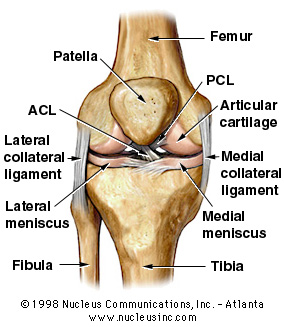Osteoarthritis: Chondromalacia!
I personally have Grade 3 chondromalacia and can no longer run or bike as a consequence… I’m in the process of re-inventing my apporach to fitness. Everything below explains the condition:
Osteoarthritis is usually graded as different forms of chondromalacia (wearing down of the cartilage surface). Grade 1 chondromalacia is some early damage to the cartilage surface, while grade 2 chondromalacia involves pitting and fissuring of the cartilage surface. Further damage with fissuring down to the bone is called grade 3 chondromalacia, while complete wear of the cartilage and exposed bone is called grade 4 chondromalacia. One should specifically avoid those activities which cause symptoms because the symptoms indicate that the arthritis is becoming worse.
Articular Cartilage Defects of the Knee Steve A. Mora, MD
Three bones meet within the knee joint: the femur (thighbone), the tibia, (shin), and the patella (kneecap). Like many other joints or “articulations,” the surfaces of these bones are covered with a durable slick lining called articular cartilage. Articular cartilage different than meniscus cartilage. Articular cartilage serves as the slick pearly white lining of the joint in contrast to the 2 menisci that lie on the surface of the tibia and which serve as shock absorbers between the tibia and the femur. Articular cartilage has unique biochemical and physical qualities which confer nearly frictionless characteristics. When functioning properly articular cartilage has less friction than 2 pieces of ice sliding on each other.
Articular cartilage defects are common conditions affecting the knee. Articular cartilage resists wear quite well, but time and wear can eventually take their toll. When the joint surface extensively breaks down, the condition is known as degenerative arthritis or osteoarthrosis (OA). If a severe twisting or impact injury occurs, such as following an ACL rupture or fall, a focal area of cartilage injury may occur. These traumatic lesions are referred to as an articular cartilage injury or chondral injury. Since articular cartilage has such poor healing qualities, these injuries will rarely heal or regenerate spontaneously. In addition to causing pain and restricted mobility, injuries to joint cartilage over time may lead to further deterioration. A lesion which originated following trauma may take on a degenerative appearance over time. The symptoms of damaged articular cartilage may severely hinder normal activities and occupation, i.e. functional impairment. The severity of the pain and dysfunction depends on the size and the depth of the injury. Surgeons are able to “grade” the severity and complexity of articular cartilage defect based on the depth of the injury. Grade I- is very mild with softening, Grade II includes fissuring or crater depth less than half the full thickness, Grade III is a deep defect that is through most of the thickness of the cartilage, and the most severe, Grade IV is a full thickness defects with exposed bone. The higher grade lesions such as the III or IV can have major negative impact on a person’s function.
No responses yet

